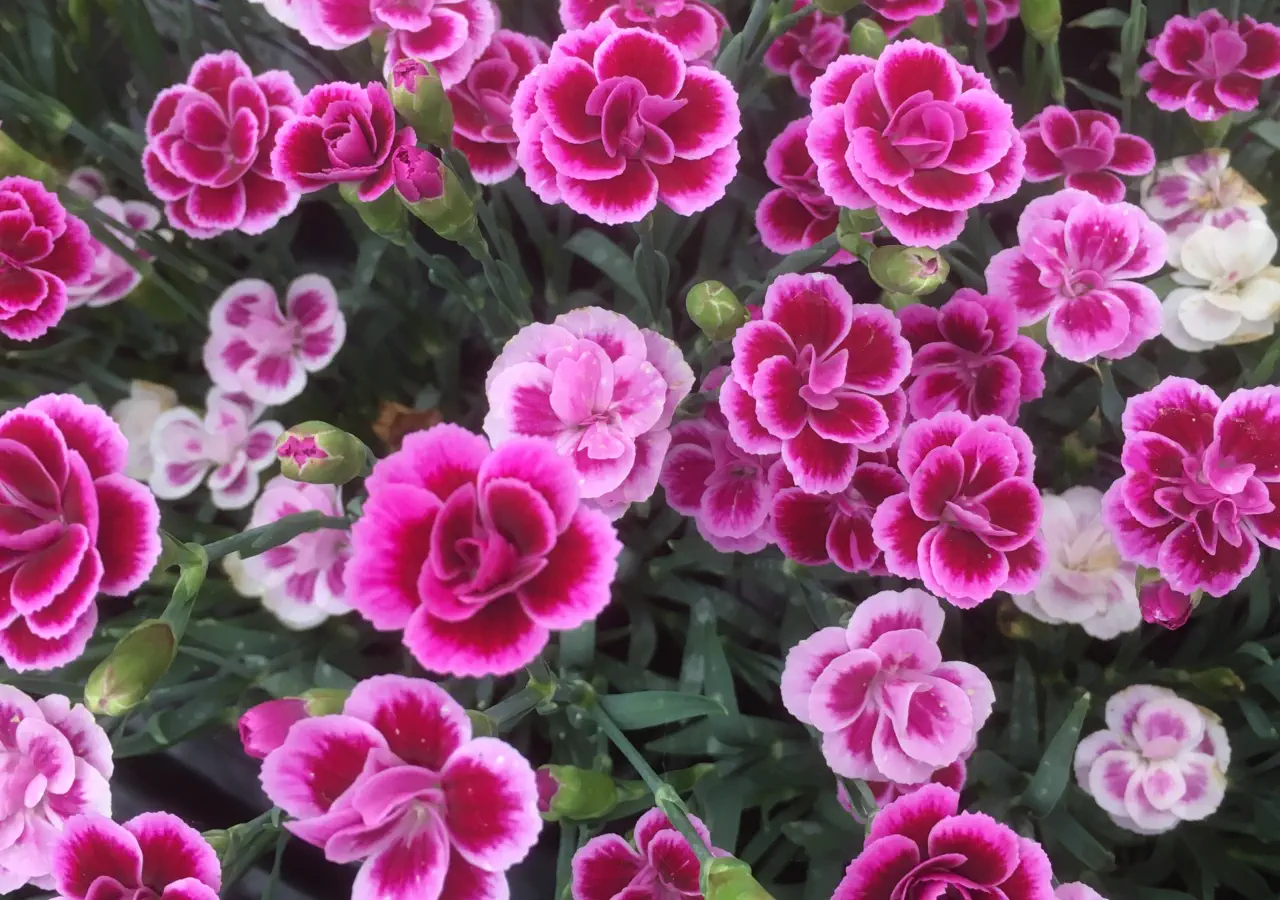Everything You Need to Know About Dianthus Pink Kisses

Few plants bring as much charm and cheer to gardens as Dianthus ‘Pink Kisses’. With its compact form, delightful scent, and eye-catching two-tone blooms, this little beauty is a favourite among gardeners looking for a long-lasting, low-maintenance plant. Perfect for pots, borders, or gifting, it’s no wonder that ‘Pink Kisses’ has become a go-to variety for adding a splash of colour and fragrance to outdoor spaces.
In this guide, we’ll explore everything about Dianthus ‘Pink Kisses’—from its features and care needs to creative ways you can use it in your garden.
What is Dianthus ‘Pink Kisses’?
Dianthus, often referred to as "pinks," is a genus of flowering plants in the carnation family. ‘Pink Kisses’ is a modern hybrid variety prized for its compact growth habit and distinctive flowers. The blooms feature a central deep pink eye surrounded by pale pink petals, creating a striking contrast. They also carry the signature sweet, clove-like fragrance that makes Dianthus so beloved.
Native to Europe and Asia, Dianthus thrives in temperate climates and has been cultivated for centuries. ‘Pink Kisses’ builds on this tradition with its improved flower production and longer blooming season.
Why Choose Dianthus ‘Pink Kisses’?
1. Stunning Blooms
The bi-coloured flowers are truly unique and add a pop of colour to any setting. They bloom profusely from spring through late summer, with the potential for intermittent flowering into autumn.
2. Compact Size
At just 20–25 cm tall and wide, ‘Pink Kisses’ is ideal for smaller gardens, containers, and even windowsills.
3. Fragrance
The sweet, spicy fragrance of Dianthus ‘Pink Kisses’ is a joy, especially when planted in places where you can enjoy it up close, like patios or near doorways.
4. Low Maintenance
This variety is easy to care for, making it perfect for beginners or those with limited gardening time.
5. Great for Pollinators
Bees and butterflies adore Dianthus flowers, making ‘Pink Kisses’ an excellent choice for supporting local wildlife.
How to Care for Dianthus ‘Pink Kisses’
Dianthus ‘Pink Kisses’ is remarkably easy to grow, but a little care will go a long way to keep it thriving.
Light
This plant loves sunlight! Aim to place it in a spot that gets full sun for at least 6 hours a day. While it can tolerate some light shade, the blooms will be less abundant in lower light conditions.
Soil
Dianthus prefers well-draining, slightly alkaline soil. If planting in containers, use a high-quality potting mix with added grit or sand for improved drainage.
Watering
Water regularly, especially during dry spells, but avoid overwatering. Dianthus ‘Pink Kisses’ doesn’t like sitting in soggy soil, so ensure containers have good drainage holes.
Feeding
Feed your plants every 4–6 weeks with a balanced liquid fertiliser to encourage healthy growth and continuous flowering.
Pruning
Deadheading—removing spent flowers—encourages new blooms and keeps the plant looking tidy. At the end of the growing season, trim back the foliage to maintain a compact shape.
Hardiness
Dianthus ‘Pink Kisses’ is hardy down to around -5°C, making it suitable for most UK gardens. In colder areas, consider providing some winter protection, such as a cloche or moving pots to a sheltered location.
Creative Ways to Use Dianthus ‘Pink Kisses’
1. Container Gardens
The compact size of ‘Pink Kisses’ makes it perfect for pots and planters. Pair it with trailing plants like lobelia or ivy for a stunning mixed display.
2. Borders and Edging
Plant ‘Pink Kisses’ along the edge of flower beds or borders to create a low-growing, colourful border.
3. Gift Plants
Thanks to its manageable size and pretty appearance, ‘Pink Kisses’ is a popular gift for birthdays, Mother’s Day, or simply to say “thank you.” It’s an affordable, living alternative to a bouquet.
4. Balcony or Windowsill
If space is limited, ‘Pink Kisses’ thrives in small containers, making it perfect for balconies or sunny windowsills.
5. Cut Flowers
While not as long-lasting as larger carnations, the blooms of ‘Pink Kisses’ make a lovely addition to small indoor arrangements.
Common Issues and Tips
Although Dianthus ‘Pink Kisses’ is generally problem-free, it can encounter a few challenges:
- Yellowing Leaves: This is often due to overwatering or poor drainage. Check your watering habits and ensure the soil isn’t too soggy.
- Leggy Growth: If the plant becomes straggly, it’s likely not getting enough sunlight. Move it to a sunnier spot if possible.
- Pests: Aphids or spider mites can occasionally appear. Treat infestations with insecticidal soap or a strong jet of water.
- Powdery Mildew: If the foliage develops a white, powdery coating, this fungal disease could be the culprit. Improve air circulation around the plant, by ensuring there is space around for air to flow and avoid watering the leaves from overhead.
Fun Facts About Dianthus ‘Pink Kisses’
- Name Origin: The name “Dianthus” comes from the Greek words dios (divine) and anthos (flower), meaning “divine flower.”
- Award-Winning Variety: Dianthus ‘Pink Kisses’ has won multiple awards for its garden performance and beauty.
- Longevity: In the right conditions, Dianthus plants can live for several years, providing reliable colour year after year.
Why You Should Grow Dianthus ‘Pink Kisses’
Whether you’re an experienced gardener or just starting out, Dianthus ‘Pink Kisses’ is a brilliant choice. It’s compact, easy to care for, and produces a stunning display of fragrant flowers throughout the growing season. From brightening up a balcony to creating romantic garden borders, this delightful plant is as versatile as it is beautiful.
So why not add Dianthus ‘Pink Kisses’ to your garden this year? Its cheerful blooms and sweet scent are guaranteed to bring a smile to your face.
